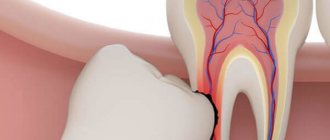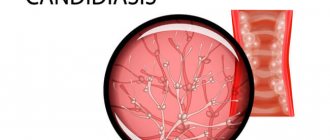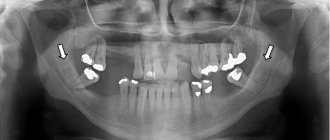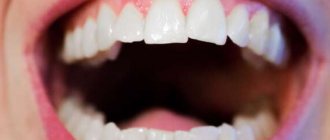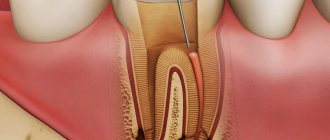After tooth extraction, patients closely monitor the healing process of the hole. And usually everything goes well - the wound heals, new tissues form, redness in the area of the injured gum disappears. But sometimes frightening formations appear - lumps, hematomas, compactions. Of particular concern is the white growth after tooth extraction. In this case, consulting a doctor is advisable, since the growths can be both safe and requiring treatment.
Content:
- In what cases are molars removed?
- Reasons for the formation of a lump after wisdom tooth removal
- Dangerous symptoms
- How to treat a lump after tooth extraction
- What happens if you don’t treat a lump after a tooth extraction?
Most patients at dental clinics believe that pulling out a diseased tooth will relieve them of painful symptoms.
They treat the extraction procedure as a life-saving one. But, unfortunately, it is not always possible to solve the problem completely surgically. It happens that a small tumor soon forms in the vacant space. A seal on the gum after tooth extraction indicates the need to urgently visit a doctor. Below we will tell you why it occurs and how doctors fight it.
Types of seals and the probable cause of their appearance
Most often, a lump on the gum occurs due to diseases of the oral cavity. Usually it is localized on the upper jaw, causing discomfort and pain, sharp and aching, which does not give rest. In some cases, the problem remains hidden for a long time. The main factors that provoke growth include:
- soft tissue infection;
- trauma to the mucous membrane as a result of taking spicy, sour foods, alcohol, and a number of medications.
Hard white bumps on the gums are an alarming symptom and a reason to see a doctor as soon as possible. After removal, hematomas are fluid-filled tumors.
They have a reddish tint and are not particularly dangerous. However, they need to be shown to a doctor and never pierced or disturbed. In this case, they gradually dissolve. The following types of pathological changes occur:
- Dense cone of white color. Evidence of an infectious process. There is pain when you press it.
- A bloody lump (hematoma) at the site of an extracted tooth. A consequence of soft tissue injuries during surgical procedures or inflammation.
- Hard lump. The cause may be a piece of bone tissue that was not removed. It does not necessarily cause pain, but it disturbs the patient.
hard lump
If a hard lump appears, it is important to show it to the dentist. The abscess should not be heated; to alleviate the condition, you can apply ice to the cheek on the problematic side. During diagnosis, the doctor may use palpation, periapical x-rays and tomography. In case of inflammation, the surgeon opens the lesion and clears the cavity of pus. The wound is washed with an antiseptic solution and a paste is applied. At home, antibiotics and anti-inflammatory therapy, rinses, and special ointments are prescribed. Monitoring is necessary until the gums heal completely.
Soft red ball
If tooth extraction was difficult and lengthy, a soft red ball may appear on the gum. Inside there is a bloody fluid - a good environment for the spread of infection and suppuration in the future. You cannot pierce the abscess or touch it with your hands. You should also not assume that the lump will go away on its own. The most correct thing is to consult a doctor who will do everything necessary to eliminate it and, if necessary, open it.
In what cases are molars removed?
Medical indications for extraction are:
- Progressive odontogenic osteomyelitis of the jaw. It is a purulent infectious-inflammatory lesion that affects not only the root of the molar, but also the tissue adjacent to it. Leads to increased body temperature, weakness, and abscess. For osteomyelitis of this type, tearing out the “causal” unit should be done in line order. Under no circumstances should surgery be postponed. Otherwise, the pathological contents of the abnormal focus will be evacuated into the jaw bone. There is a possibility of it entering the systemic circulation.
- Purulent periostitis, phlegmon, abscess, lymphadenitis, sinusitis of the maxillary sinus , if it is impossible to ensure a high-quality outflow of purulent masses from the infectious focus in the jaw.
- Lack of effect after conservative therapy for any purulent-inflammatory lesions of the oral cavity.
- Complete destruction of the crown and unsuitability of the remaining roots for prosthetics. Damaged root canals are a chronic source of odontogenic infection, so they have to be disposed of.
- The presence of teeth in the area of fracture of the alveolar process or jaw bone. Such units do not allow the correct composition of bone fragments and are regarded as conduits for infection.
- Impacted units, during the eruption of which a strong infectious-inflammatory reaction , tumor or cyst developed.
- Fangs, incisors and molars, due to which the mucous membranes of the mouth are constantly injured. They can be pulled out if standard sanding does not stabilize the situation.
- Progressive periodontitis , if loosening has reached the third or fourth stage.
- of a malignant tumor in the tissues of the periodontium or alveolar process
- Severe malocclusions , when “neighbors” do not allow the aligned units to take the correct position.
- Supernumerary teeth , causing curvature of the row, disrupting the aesthetics of the face.
Introduction to bone grafting surgery
Bone grafting is an operation to correct bone deficiency in the area of the jaw required for implantation. There are 4 main methods:
- GBR or directed bone regeneration involves the use of bone replacement materials and growth stimulants that accelerate the regeneration of one’s own bone cells. The top is covered with barrier membranes to prevent displacement.
- Splitting of the alveolar process Installation of the graft inside the bone, where there are the most favorable conditions for engraftment. Rarely used, suitable only for patients with dense jaw walls.
- Bone block grafting Fixation of a graft from the patient's own bone taken from another area of the jaw. A traumatic method, practically not used. Suitable for patients if the body does not accept any other material other than its own.
- Sinus lifting is performed on the upper jaw under the bottom of the maxillary sinus. The sinus lining is lifted and filled with osteomaterial to create the necessary volume of bone to support the implant.
Surgical interventions differ in technology and degree of tissue trauma. Our Center uses gentle protocols without a hammer, saw or chisel. NSK VarioSurg ultrasound technology allows minimal trauma to bone tissue during surgery, eliminating damage to blood vessels, nerves, and the lining of the maxillary sinus. Unpleasant consequences after surgery appear to a minor extent.
The operations are performed under sedation - in a state of controlled drug sleep without the pain of unpleasant memories. The drugs do not have a negative effect on the body; this is not general anesthesia with a difficult recovery.
The duration of the procedure is from 30 minutes (for bone restoration in the area of 1-2 teeth) to 3 hours (for large-scale interventions).
hospitalization required after surgery
After waking up, you can go home 30-40 minutes later. For patients with cardiac problems, our Center provides a day hospital, where you can lie down under the supervision of an anesthesiologist.
Levin Dmitry Valerievich
Founder and Chief Doctor of the Center
Reasons for the formation of a lump after wisdom tooth removal
The problem occurs for various reasons. Most often, a lump is formed due to:
- Severe injury to gum tissue. In this case, the disorder may be non-infectious in nature and go away on its own in two to three days. Anti-inflammatory drugs prescribed by a dental surgeon will help get rid of it. A particularly traumatic operation is to tear out “eights”, the roots of which are very long and winding.
- Individual intolerance to drugs used to treat the wound. Allergies cause itching and swelling. Increased separation of watery exudate is possible. To relieve unpleasant symptoms, you must stop using medications. The dentist will help you choose a more suitable analogue.
- Attachments of the inflammatory-infectious process. It occurs if bacteria enter the open socket, which is possible with an unformed blood clot. A complication in the form of a “dry” socket is likely if the doctor violated the extraction technique or the patient did not follow the instructions of the dental surgeon during the recovery period.
- Formation of flux in the operated area. Periostitis is manifested by purulent discharge, swelling of soft tissues, and increased body temperature. After extraction, it occurs due to the fact that pathogenic flora penetrates into the open wound cavity.
Causes
After a tooth has been removed, alveolitis of the socket often occurs. Certain factors may contribute to this:
- the blood clot, which prevents infection from entering the wound, has been destroyed;
- bone fragments, stone, plaque got into the hole during the removal procedure;
- the specialist did not clean the hole very well from granulations and granules;
- sterility was compromised;
- the removal was very traumatic;
- the patient did not follow all the doctor’s instructions;
- The patient's body is exhausted, immunity is quite low.
When a regular tooth or wisdom tooth has been removed, you should not rinse your mouth too vigorously, as there is a risk that the blood clot located in the socket will be washed out. The result is that microbes get inside and provoke an inflammatory process.
Dangerous symptoms
If a lump appears after tooth extraction, you should inform your doctor about it. Particularly dangerous symptoms are:
- discharge of pus;
- severe swelling;
- acquisition of bluish tint by fabrics;
- pain on palpation;
- absence of a protective blood clot.
Trying to cure a disorder without medical help is not only unwise, but also dangerous. By engaging in amateur activities and experimenting with folk recipes, a person risks creating conditions for the further spread of the inflammatory process. Then it is possible that the extraction will be followed by a second operation. This time it will be aimed at removing tissues affected by the purulent process.
Condition after bone grafting - normal and complications
Within 10 days, unpleasant conditions are possible that accompany any surgical operation and are considered a physiological norm. The intensity of the manifestations depends on the experience of the surgeon, the technologies used, the type of bone grafting, the scope of the operation and the individual characteristics of the body.
Pain
You will not feel pain immediately after the operation; our anesthesiologist will administer an anesthetic along with sedatives. Anxiety may appear towards the end of the day or the next day. The initial intensity of sensations can be completely different, depending on the person’s pain threshold.
To relieve pain, take the medications from the kit you received at the reception. The sensations should completely go away within the first week after surgery.
Bleeding
Bloody discharge may occur during the first 2-3 days. Normally, they should be quite scanty, just tint the saliva a little. The appearance of blood clots or severe bleeding is a reason to immediately visit a doctor.
You can stop the bleeding yourself by pressing the wound surface with a sterile bandage. Avoiding severe bleeding will help avoid taking non-steroidal anti-inflammatory drugs, in particular acetylsalicylic acid. Some patients, according to indications, are forced to take antiplatelet agents and anticoagulants; it is worth warning the surgeon about this at the stage of preparation for surgery; a corrective plan may be needed.
Edema
Tissue damage and the introduction of osteoplastic material always lead to the development of swelling. It is most pronounced 2-3 days after surgery, then quickly subsides. Swelling can be managed by applying ice compresses. You need to sleep on a large pillow so that your head is elevated.
The swelling goes away by the end of the first week after surgery. Otherwise, there is suspicion of a pathological process of inflammation of the wound surface or deep-lying structures.
Please be extremely attentive to your own condition. For any questionable symptoms, if there is a worsening of discomfort or lack of positive dynamics, consult a doctor. The 24-hour helpline number is located on the post-op advice card .
How to treat a lump after tooth extraction
The technique of dealing with a dental disorder depends on the factors that caused it. First, the doctor studies the dominant symptoms and carries out various diagnostic measures. Based on the data obtained, he makes a decision on an effective treatment technique. She may be:
- conservative;
- surgical.
In the first case, we are talking about cleansing tissues from purulent masses and carrying out drainage measures. The patient is prescribed medications of different pharmacological groups. These can be antibiotics, anti-inflammatory, antiseptics, agents that suppress the activity of pathogenic flora, regeneration stimulants, pain relievers.
Medicines can be taken orally. They are also applied to the affected area. The rinses have proven themselves to be excellent. With their help, it is possible to speed up the evacuation of the contents of a purulent lesion.
Surgical therapy is indicated if there is a dense sac on the gum containing dead tissue. Then the surgeon makes a small incision and installs a drainage tube into the formed cavity. The exudate leaves the pathological focus along it. When the lump subsides and all the pus is removed, the doctor stitches it up. To avoid complications, the patient is prescribed antibacterial agents.
Oral care after bone grafting
Proper oral hygiene is important to prevent complications. Caring for your teeth and the operated area should be thorough and gentle.
- Brushing your teeth is recommended after every meal for several days after surgery.
- Use only a soft toothbrush
- During cleansing, do not touch the operated area.
- Active rinsing of the mouth with antiseptics is prohibited; oral baths are allowed
- Treatment of operated areas is carried out with moistened cotton swabs
- The wound surface and sutures should be treated extremely carefully to avoid mechanical damage.
Cleaning the mouth after eating should be thorough but gentle. In the first days after surgery, it is quite easy to cause bleeding or suture dehiscence.
Read more about the rules of care - Oral care
What happens if you don’t treat a lump after a tooth extraction?
There are two options here:
- the neoplasm will resolve on its own within three to five days;
- the inflammatory process will progress and the situation will worsen.
Should we hope for a favorable outcome without medical help? Of course it is possible. Moreover, this is what happens in most cases. However, the risk of refusing to receive medical advice is always large and unfounded. There is no need to expect that the lump will resolve on its own. Having received medical advice, a person avoids many troubles.
If the doctor determines that the tumor does not pose a threat to health and is a normal variant, he will simply tell you to wait. If the diagnosis shows the presence of a dental disease, it will be treated. In both cases, the patient will benefit - he will maintain the health of his smile and avoid complications dangerous to the body.
Take care of yourself and don’t let dental problems take their course. Otherwise, very soon you will need prosthetics or implantation.
Medicines during the rehabilitation period
After the operation, you will receive a set of medications to take home and instructions for their use. Taking medications can reduce the risk of infection and relieve unpleasant symptoms.
Patients are prescribed:
- Antibacterial agents Most often, combination drugs are used that cope well with infections of the oral cavity and upper respiratory tract. A standard seven-day course is prescribed, which minimizes the risk of an inflammatory process. During this period, you should not drink alcoholic beverages or take medications that suppress the immune system, such as hormonal drugs (prednisolone).
- Antihistamines Help relieve swelling, which is pronounced in the first days after bone grafting and can cause serious inconvenience to the patient. As a rule, tablet forms of the drug are used.
- Antiseptic solution In most cases, Chlorhexidine is used. It is used to treat the oral cavity, but not to rinse. Helps fight pathogenic microorganisms in the wound surface area.
- Analgesics Painkillers that help eliminate severe pain during the first days after bone grafting. The drugs should be taken as prescribed by a doctor, most often one tablet with a break between doses of at least 4 hours.
- Healing ointment Topical application accelerates tissue regeneration. Used for rapid healing of the wound area.
An individual set is compiled for each patient , depending on the type and volume of the operation. Self-administration of medications is strictly prohibited; it can significantly increase the risk of complications or harm the body as a whole.
Read more here - Medications after surgery
Diagnosis and treatment
To clarify the diagnosis, the doctor examines the patient. In the early stages of formation, the cyst is not always visible, so an X-ray of the jaw is taken.
There are several methods for treating cysts.
- Drug therapy. Effective at the initial stage, when the cyst is just forming. Aimed at suppressing the inflammatory process, it includes rinsing with antiseptic solutions, taking antibiotics, and local treatment of the affected area of the gums with ointments and gels.
- Surgical intervention. Indicated if the diameter of the cystic formation exceeds 1 cm. During the operation, the doctor can remove the cyst along with the fibrous capsule or install a drainage to drain the purulent contents.
What is peri-implantitis?
Peri-implantitis is an inflammation of the tissues and bone surrounding the implant, which ultimately, without timely intensive treatment, leads to bone loss and loss of the implant.
Peri-implantitis is much easier to prevent than to stop a process that has already begun. The main cause of the disease is a bacterial infection, which can occur either at the moment of implantation, and then the symptoms of the disease appear a few days after the operation, or after some time - from several months to several years.
General recommendations after bone grafting
Following your doctor's recommendations during the rehabilitation period will prevent possible complications. The list is in the medicine package.
General recommendations after bone grafting:
- At first, it is better to refrain from chewing on the operated side.
- For the first 2-3 days it is recommended to eat only crushed food at room temperature
- You should not smoke or drink alcohol for 2 weeks after surgery.
- Do not drink through a straw
- It is recommended to cough gently and with your mouth open so as not to increase the pressure in the mouth.
- Sleep better with the head of the bed raised
- Serious physical activity and diving for several weeks are prohibited
- Prolonged exposure to the sun is not recommended; you should avoid visiting solariums.
- It is prohibited to visit the sauna or bathhouse
- You should avoid flying in the first few weeks after bone grafting.
The patient must maintain physical and emotional rest. The doctor will monitor your condition and monitor you during scheduled visits.
